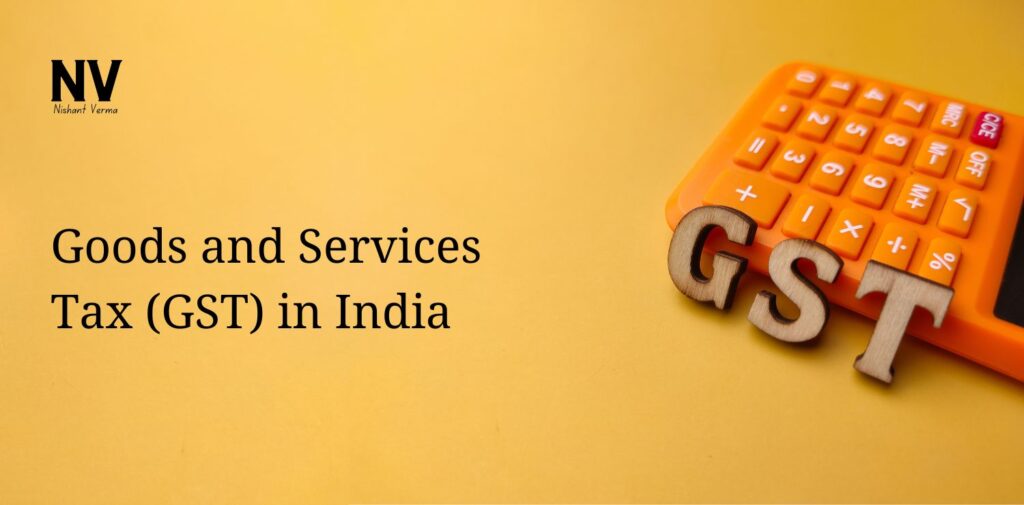Goods and Services Tax in India, commonly known as GST, is a significant tax reform in India that aims to simplify the taxation system of India. It replaced a complex structure of multiple taxes with a single unified tax, making it easier for businesses and consumers to understand and comply with taxation regulations.

What is Goods and Services Tax in India?
GST is a comprehensive indirect tax levied on the supply of goods and services. Unlike the earlier tax system, which included various taxes like excise, service tax, and VAT, GST brings everything under one roof. It is a destination-based tax, meaning it is levied where goods and services are consumed.
The GST Council: Decision-Making Body
The GST Council plays a crucial role in the implementation and modification of GST. It is a joint forum where the central and state governments come together to make decisions on important issues like tax rates, exemptions, and threshold limits. This collaborative approach ensures a uniform tax structure across the country.
GST Structure: SGST, CGST, and IGST
Under GST, the tax is divided into three components: State Goods and Services Tax (SGST), Central Goods and Services Tax (CGST), and Integrated Goods and Services Tax (IGST). SGST and CGST are levied by the state and central governments, respectively, on intra-state transactions. IGST is applicable to inter-state transactions.
GST Registration: Who Needs to Register?
GST registration is mandatory for businesses with an annual turnover above the prescribed limit. It helps the government track economic activities and ensures compliance. Small businesses with turnover below the threshold limit can voluntarily register for GST, which can also provide them with certain benefits.

GST Rates: Understanding the Slabs
GST has multiple tax slabs to categorize different goods and services based on their nature and importance. The slabs are 5%, 12%, 18%, and 28%. Essential commodities often fall under lower tax slabs, while luxury items attract higher taxes. Some items, like healthcare and education services, may be exempt from GST.
Input Tax Credit: Reducing the Tax Burden
One of the advantages of GST is the concept of Input Tax Credit (ITC). Businesses can claim credit for the taxes they paid on inputs when calculating their final tax liability. This mechanism prevents the cascading effect of taxes and encourages smoother business operations.
Composition Scheme: Simplifying Compliance for Small Businesses
The Composition Scheme is designed to ease the compliance burden for small businesses. Eligible businesses can opt for a fixed rate of tax and file quarterly returns instead of regular monthly filings. This is particularly beneficial for businesses with a turnover below a certain limit.
Reverse Charge Mechanism: Shifting the Liability
In certain cases, the liability to pay GST is shifted from the supplier to the recipient. This is known as the Reverse Charge Mechanism. It is applicable to specific goods and services, and the recipient is responsible for paying the tax directly to the government.
E-Way Bill: Ensuring Seamless Transportation
To track the movement of goods and curb tax evasion, the E-Way Bill system was introduced under GST. It is mandatory for the transportation of goods above a specified value. The bill contains details of the consignment, and it must be generated online before the commencement of the movement of goods.

GST Returns: Filing and Compliance
Businesses registered under GST need to file regular returns to maintain compliance. These returns include details of sales, purchases, and the tax paid. The frequency of filing varies based on the type of business and its turnover. Non-compliance may lead to penalties and legal consequences.
Anti-Profiteering: Preventing Unfair Practices
The anti-profiteering provision under GST ensures that businesses pass on the benefit of reduced taxes to consumers. If there is evidence of businesses not reducing prices in line with the lower tax rates, the anti-profiteering authority can take corrective measures.
GST and the Common Man: Impact on Prices
GST has a direct impact on the prices of goods and services. While some items may become cheaper due to lower tax rates, others may see an increase. Understanding the new tax structure helps consumers make informed decisions and adapt to the changes in the cost of living.
Challenges and Benefits of GST Implementation
While GST has streamlined the taxation system, its implementation has not been without challenges. Businesses faced initial difficulties adapting to the new regime, but over time, the benefits of a simplified tax structure, reduced compliance burden, and improved logistics have become evident.
Future of GST: Continuous Evolution
GST is not a static system; it evolves based on feedback, economic conditions, and technological advancements. Continuous efforts are made to simplify procedures, reduce complexities, and address any issues that arise during implementation.
Conclusion: Embracing the Simplicity of GST
In conclusion, the Goods and Services Tax in India represents a significant step towards a more straightforward and unified tax system. Understanding its key components, such as the GST Council, tax slabs, and compliance mechanisms, empowers businesses and consumers alike to navigate the taxation landscape with ease. As GST continues to evolve, its positive impact on the economy and ease of doing business in India is expected to grow, marking a transformative era in the country’s fiscal policies.




